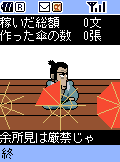|
Be an iMode Mifune? |
||||||||||||||||||||
|
WGR reviews Samurai Romanesque by Dwango |
||||||||||||||||||||
Add one word to a now familiar genre and you've started what sounds like a revolution: mobile massively multiplayer online role-playing. While Samurai Romanesque is not entirely multiplayer, and not entirely online, it is a remarkable early attempt to build a game for mobile phones oriented toward continuous communal play. Released in Japan in January 2001, Samurai Romanesque offers a fantasy feudal Japan where thousands of gamers can play samurais and warlords by punching buttons on their mobile phones. Currently, Samurai Romanesque is available only in Japan, and only over NTT DoCoMo's popular I-Mode service.
Samurai Romanesque was developed by Dwango, which was originally an American company. Dwango, which stands for "Dial-up Wide Area Network Game Operation," was founded in Houston, Texas in 1994 to provide multiplayer access via modem for PC games like DOOM. The original company shut down in 1998 when multiplayer gaming abandoned modems for the Internet. Since then the Japanese subsidiary has become a leading content-developer for Japan's mobile gaming market. Dwango suspected that Samurai Romanesque would prove difficult to play for people who weren't familiar with electronic role-playing games and networked gaming. They envisioned Samurai Romanesque as a game for people who had graduated from the first-generation of simple i-mode games, or people who might have played video game console role-playing games like Dragon Quest or Final Fantasy. Samurai Romanesque consists of three separate types of Java applications (applis) that players download to their mobile phone. Each of these application types offers a separate and distinct gaming experience. Ancient Samurai Twitch Gaming
Gamers looking to play Samurai Romanesque but save yen in connection fees will spend most of their time with the training applications. There are three training applications which you play offline: Sword Training, Physical-Strength Training, and Mind Training. By performing vintage arcade game tasks that rely primarily on hand-eye coordination, you boost particular character statistics and resources for use in the multiplayer appli. Sword Training consists of three mini-games: Flying-Bow game, Cutting Big Tree game,and Hitting Persimmon game. For example, in Flying Bow game, which develops speed, arrows fly at you! Press your button at the right time to slice them with your sword! Can you keep slicing as the arrows fly faster and faster? Similarly arcade-oriented, Physical-Strength Training includes Landing game, Fight the Ninja and Clearing hurdles. The Landing game is familiar to anyone who has played some of the earliest computer and video games: Little men drop bales of hay and bombs from atop a wall; you run underneath with a basket on your head. Can you catch all the bales but not the bombs?
The Mind Training appli, which Dwango says develops "patience," consists of more esoteric games: Zen Koan Dialogue, Waterfall, and Part-Time Job. Sachiko Kurokawa from Dwango described that last mini-game in its historical context: "The Part-Time Job game is unique. Masterless samurais were so poor that they had to earn money from their part-time jobs. In this game, players must make as many unmbrellas as possible. Making umbrellas was known as a popular job for samurais." Almost all of these games are old school arcade throwbacks, reminiscent of the Nintendo Game & Watch. They are ideally suited for the small screens and minimal interfaces of today's mobile phones. These games can be played quickly, and you're not connected to the network when you play. Perfect for a speeding subway car. The appli keeps track of your performance and uploads your statistics to the Samurai Romanesque server. So you can turn those few extra moments of slicing arrows or making umbrellas into tangible samurai development. All of this training is manifested in the main application, where the proper electronic role-playing takes place. In graphics reminiscent of 8-bit Nintendo or GameBoy titles, your diminutive samurai character wanders through villages in feudal Japan. There are more than 1,000 villages in the game, and in each of them there might be some local event, a festival or some special food you can taste. It's sight-seeing through a small window - the events are rendered using small pictures and text in Japanese. According to Kurokawa at Dwango it should take six real-world months of game playing to see all the sights in Samurai Romanesque.
In each village, you might find a shop, a teacher, and a drunken belligerent looking for a fight. Fights are handled through a combination of statistics matching, button mashing (how fast can you hit indiscriminate buttons?) and memory (a sequence of numbers flashes on the screen -- how fast can you remember and type it in?). It's called Romanesque for a reason
The lifespan of your character in the game is around 40days of game play. After that time your character passes away. But you can perpetuate your legacy in the game world through procreation with one of the ladies you meet in your travels. You'll run into ladies and if you hit it off with one in-game lady you can continue to communicate with her and perhaps eventually marry her. If you meet a gal and she likes you but you don't reciprocate, we're told you have to run away. If you do manage to marry, most likely you'll have a child. After your current character dies, you continue play as your child, with most of the same statistics intact. This is useful considering the vast scope of the game. Feudal Japan is recreated as a series of warring nation states, and it's possible for you to accumulate reputation and power enough that you might eventually lead a political unit and make war on another group.
Whether you are a leader or an ordinary soldier, you can participate in war after you turn thirteen years old. If you are inclined to fight, you can visit the local castle to pledge your allegiance to the master of the kingdom. Wars break out once a week, with the game server selecting which countries will fight. If your kingdom is involved, you'll be notified that you're needed for battle. When you log on, you'll find your countrymen on the battlefield. Rushing across the field of battle in the company of your loyal soldiers, you come across an enemy. And then it's a battle as usual; sword fighting with mobile phone button mashing. The total number of battles won by each side is tallied and after some time one side is declared a winner.
Throughout all this play, you'll see many other player characters wandering the landscape alongside you. Unfortunately, you can't communicate with them in the main game. There are public bulletin boards in the game world where you can post messages composed of words and phrases pre-selected by the game. Occasionally as you wander between villages you'll have random battles. If it's not against a red or blue computer soldier, you're battling another Samurai Romanesque gamer. In addition to the Training and Multi-player applis, there is also a third application provided for chat and conversation. Here you can talk strategy, tell stories, or do battle as your character. You can't, unfortunately, arrange to meet and duel with a specific friend or foe in the chat appli, only with other random Samurai Romanesque gamers. In all cases, the other players you meet remain anonymous, in accordance with DoCoMo's policies forbidding introductions between strangers visiting official content sites on its mobile phone networks. Romanesque Roundup
Multiplayer role-playing games are famous for demanding untenable amounts of a user's time. Some folks have even hired people to play PC multiplayer games for them because they don't have time to maintain their reputation in their adopted online game world. Mobile phones at once aggravate and ameliorate this time-sink problem. Mobile phones are the perfect device for stealing a few minutes here and there to play. So instead of devoting marathon sessions in front of your PC, you might be able to sustain your online life in short bursts if the game is designed to support it. The drawback is that each moment you can spend with the game is likely to cost you in terms of mobile phone airtime, making a devoted MMMORPG experience an expensive proposition. Although Samurai Romanesque addresses this problem with the Training applis, playing it is still not cheap. A basic subscription to Samurai Romanesque starts at 300 yen per month (US$ 2.25). According to Dwango's Kurokawa, an average Samurai Romanesque user will spend around 3000 yen (US$ 23) each month in mobile phone minutes; a heavy user could spend more than 9000 yen (US$ 70). Still, more than 100,000 players have paid the basic fees and the sometimes serious connection expenses. Enabling people to play quick arcade games and still progress in the larger game is a smart move by Dwango. It foreshadows a future online mobile phone game in which players can drop in and find community or fun for short or long bursts, with all play drawing on the same game environment and game statistics. Also, Sachiko Kurokawa at Dwango observes it is possible to play Samurai Romanesque a few different ways: as a wandering samurai, a powerful soldier, a political warlord, or a romance-driven Don Juan. While not quite the freeform world of real pen-and-paper role-playing, it's a more expansive game experience than the button mashing would have you believe. Mobile, multiplayer, role-playing - these elements are all present largely as separate functions. More than 100,000 have found Samurai Romanesque a compelling experiment. But it's likely that, even in game-crazed Japan, the pricing model for connection time will have to change before large numbers of folks would participate extensively in a game like this. |








